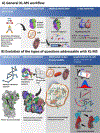Chemical cross-linking with mass spectrometry: a tool for systems structural biology
- PMID: 30172868
- PMCID: PMC6382564
- DOI: 10.1016/j.cbpa.2018.08.006
Chemical cross-linking with mass spectrometry: a tool for systems structural biology
Abstract
Biological processes supporting life are orchestrated by a highly dynamic array of protein structures and interactions comprising the interactome. Defining the interactome, visualizing how structures and interactions change and function to support life is essential to improved understanding of fundamental molecular processes, but represents a challenge unmet by any single analytical technique. Chemical cross-linking with mass spectrometry provides identification of proximal amino acid residues within proteins and protein complexes, yielding low resolution structural information. This approach has predominantly been employed to provide structural insight on isolated protein complexes, and has been particularly useful for molecules that are recalcitrant to conventional structural biology studies. Here we discuss recent developments in cross-linking and mass spectrometry technologies that are providing large-scale or systems-level interactome data with successful applications to isolated organelles, cell lysates, virus particles, intact bacterial and mammalian cultured cells and tissue samples.
Copyright © 2018 Elsevier Ltd. All rights reserved.
Figures


References
-
- Fraenkel-Conrat H and Olcott HS, The reaction of formaldehyde with proteins; cross-linking between amino and primary amide or guanidyl groups. J Am Chem Soc, 1948. 70(8): p. 2673–84. - PubMed
-
- Lutter LC and Kurland CG, Chemical determination of protein neighbourhoods in a cellular organelle. Mol Cell Biochem, 1975. 7(2): p. 105–16. - PubMed
-
- Cohen FE and Sternberg MJ, On the use of chemically derived distance constraints in the prediction of protein structure with myoglobin as an example. J Mol Biol, 1980. 137(1): p. 9–22. - PubMed
Publication types
MeSH terms
Substances
Grants and funding
LinkOut - more resources
Full Text Sources
Other Literature Sources

